Heating without unnecessary energy losses! Features of infrared heating of the house
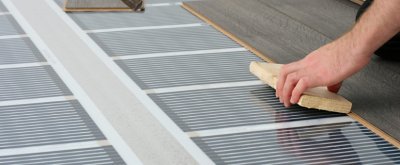
Infrared heating is one of the home heating systems. It is used both the primary and secondary method of heating a home.
Since the thermal energy is not dissipated in the surrounding space and reaches people and objects directly, infrared heaters are called "direct heating devices".
Infrared heating of the house
Infrared heating is becoming increasingly popular these days.
Operating principle
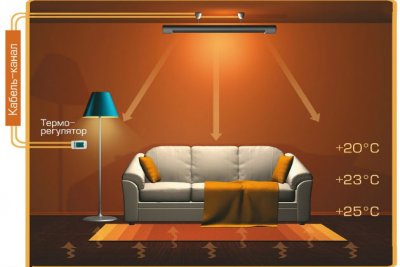
IR radiation is based on electromagnetic radiation, similar in physical properties and qualities to solar radiation.
The device consists of from two layers:
- metal, carbon or quartz layer, which acts as a heating element, the material affects the heating power;
- aluminum foil, which heats up from the metal and gives off heat into the surrounding space.
Both layers are hermetically sealed. into a dielectric that emits waves.
Modifications of infrared heaters:
- Film — heated floors are installed using film only.
- Panel — installation of the ceiling, floor and walls.
Electric current passing through a heating device is converted into heat waves with a frequency 9 microns, which heat the surrounding objects and surfaces on their way. At this time, there is no displacement of cold air and concentration of warm air at the top: the entire room is heated evenly.
Pros:
- efficiency - compared to other types of electric heating, savings are achieved up to 50% electricity, service life up to 25 years;
- quick heating of the room;
- area conservation;
- easy installation;
- ease of control;
- silent operation;
- environmentally friendly - helps eliminate fungus and dust, does not dry the air;
- safety - heaters are installed in damp rooms;
- It is even allowed for heating verandas and summer verandas.
Cons:
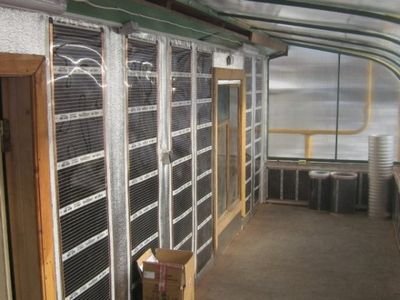
- high price of equipment;
- duration of heating large rooms;
- Prohibition on use in rooms with ceilings below 2.5 m;
- high cost of creating key conditions for efficient work: insulation and waterproofing of the house, creation of thermal shields;
- low mobility;
- maintaining the required distance from objects;
- the risk of getting burned if you stand too close to the heater;
- low temperature control range;
- smell from heated objects.
Types of IR heating
They differ in:
- Energy source:
- electrical;
- gas;
- electrogas.
- By installation location:
- ceiling;
- wall-mounted;
- floor-standing.
- By wavelength:
- Shortwave - for small spaces, with ceilings up to 3 meters, temperature up to 600 °C.
- Medium wave - medium area, ceiling height from 3 to 6 meters, temperature 600—1000 °C.
- Longwave - for large spaces with high ceilings from 6 to 8 meters, heating temperature 1 thousand °C.
Ceiling heaters
Heating devices are mounted on the ceiling — infrared radiation diverges slightly to the sides and goes to the floor, the main heating surface. Because of this the temperature at the floor is higher than at the walls or ceiling.
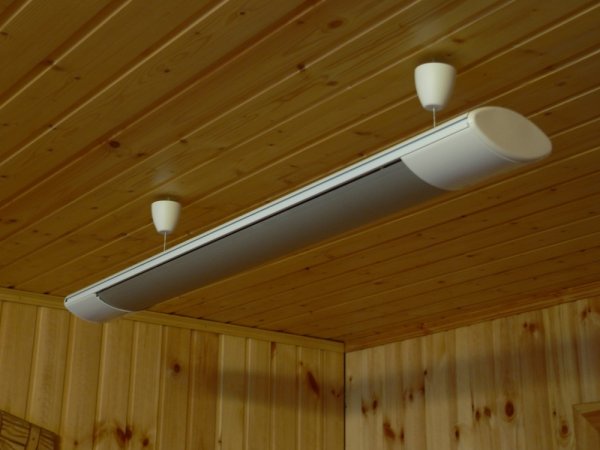
Photo 1. Infrared ceiling heater for heating the house. The device looks like a regular lamp.
Peculiarities
- the radiation diverges in a cone, capturing maximum space;
- The fastener allows you to choose optimal direction of radiation;
- can act as a "heat gun" when installed near windows or doors;
- ceiling panels imitate designer coatings.
Attention! When connecting several devices, ensure parallel connection and install a separate circuit breaker in the panel. to avoid overload.
Distance from heater to ceiling not less than ten centimeters.
Heating with infrared film
Warm floors mounted only with film mats. Flat heating elements connected in series are sealed into the dielectric.
Matami the floor is covered under the finishing coating or mounted on the ceiling. The emitted waves heat the opposite surface and objects.
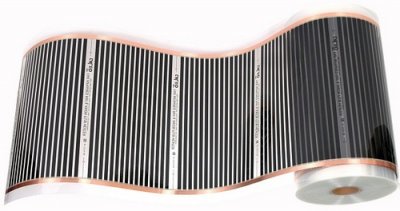
Film heaters differ several advantageous features:
- the minimum thickness of the film mat does not eat up a single centimeter of space;
- Any finishing coating can be laid on it;
- installation can be done independently without any special tools;
- safe.
Installation
Installation of film coatings requires the fulfillment of several conditions:
- Perfectly flat base. Before installation, it is necessary to carry out work to level the hydro- and thermal insulation of the base.
- Infrared stripes laid with a gap of 0.5-1 cm into the space free from furniture and connect them together with heat-insulating tape. From the wall the mats retreat no less than ten centimeters.
Important! Heating strips can only be cut according to special markings. These areas are covered with bitumen insulation, which comes with the floor.
- bend heating elements more than 90 degrees is not allowed;
- connect infrared strips in parallel copper multi-core cables with a cross-section of at least 1.5 mm2;
- on the wall for temperature control the thermostat is hung, and a thermal sensor is placed under the mat in a special recess;
- After installation, start-up work is carried out to ensure that check the serviceability matov.
The sensor is placed on thermal insulation, otherwise it will not show the real temperature of the base.
Reference. The area with film mats should be not less than 70% for heating efficiency.
Wall mounted thermal IR panels
Infrared panels are attached to the wall with special brackets And heat the opposite wall and objects, located in the path of heat waves.
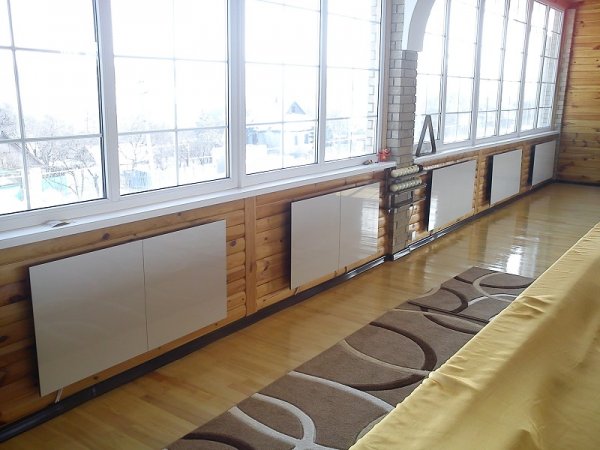
Photo 2. Infrared heating panels installed around the perimeter of the room. The devices serve as the main source of heating.
Peculiarities
- Panels combine the properties of an emitter and a convector.
- The heater is made of metal ceramicsIn this case, the device is a solid panel with a cable connected.
- Wall panel models equipped with thermostats.
- Quartz panels after switching off retain heat for a long time.
- Quartz heaters replace central heating in garages.
Infrared heating using skirting boards
Infrared skirting boards or "warm skirting boards" - a type of wall-mounted infrared heater.
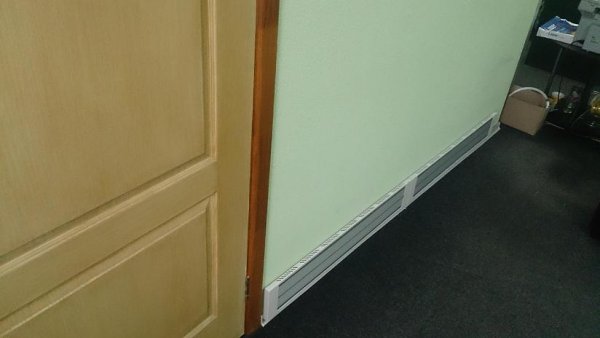
Photo 3. Infrared skirting boards for additional heating of the room. The devices warm up the floors well.
Behind a special aluminum profile that imitates a skirting board, a carbon based finned heating element. Heat rises by natural convection.
Peculiarities
- a warm baseboard is a low-power device, so it is used only as an additional tool;
- baseboards heat the floors and part of the walls;
- dries the walls, eliminates fungus and mold;
- when placed on walls in special boxes - injury from furniture is excluded, the laying area is not limited by free space.
Gas infrared heaters
An autonomous type of equipment that does not require electricity. This feature makes gas infrared heaters suitable for places where there is no connection to the power grid or where there is a risk of power surges. It heats up up to 800 °C, and quickly heats up the area up to 60 squares. For work propane or natural gas required in cylinders.
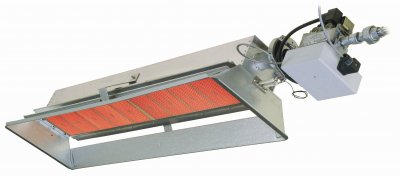
Gas infrared heaters are not intended for continuous heating of a home.
Types:
- Ceramic — a ceramic plate is used as a heating element. The gas cylinder is located in the metal base of the device. It is most often used in summer cottages, gazebos and outdoor establishments.
- Catalytic — uses both gas and electricity for operation. It is based on the principle of oxidation of substances. It is used for heating residential and industrial premises. This is a safe type.
- Street — is designed to heat terraces, sports and playgrounds, cafes in the form of an open umbrella with a heating radius of six meters. Gas cylinders are located inside the heater.
Operating principle
The same as electric ones, only gas is used:
- in the heater chamber gas mixes with air;
- the mixture passes through the holes of the ceramic plates and burns, heating the ceramics;
- heated plates emit heat waves.
Peculiarities:
- The presence of a built-in sensor for monitoring the concentration of carbon dioxide in the air. When the level in 1.5% is exceeded, the sensor will turn off the heater.
- The room is periodically ventilated.
- If large heaters are used, the room must be additionally equipped with a chimney.
IR lamps for home heating
The following are used as radiation sources: halogen lamps filled with a mixture of argon and nitrogen. These emitters both heat and illuminate. Infrared lamps are an interior detail equipped with a lamp.
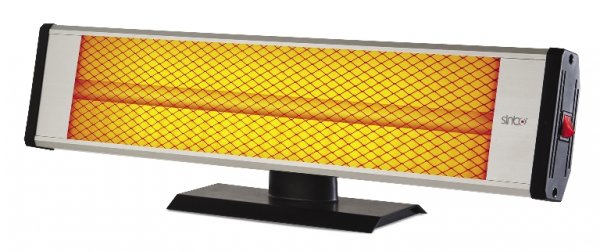
Photo 4. Infrared lamp for heating rooms. The device looks like a table lamp.
Operating principle
They resemble tungsten filament lamps. Lamps with a mirror coating that acts as a reflector are considered effective. The coating focuses the radiation on objects or specific areas. The parabola focuses the heat on a limited area, increasing the intensity of heating.
Important! IR lamp socket must be ceramic only.
Pros:
- do not require time to warm up;
- 100% the radiation quickly reaches the surface and heats it up;
- are used around the clock.
Cons:
- short life: with 24-hour use, the lamp works for about 8 months;
- afraid of moisture.
Useful video
Watch a video that talks about the advantages and disadvantages of heating with infrared film.
Conclusion
Infrared panels became a good alternative to traditional schemes heating, because:
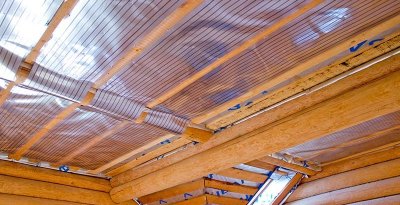
- save energy and space;
- installation is carried out taking into account the need heating of different rooms, the age of people living in the house;
- simple;
- durable;
- fit into the interior taking into account the design of the rooms.







Comments